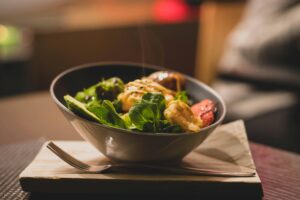Peptic Ulcer Diet: Science-Based Guide to Managing Gastric and Duodenal Ulcers
If you’ve ever struggled with the pain, burning, or discomfort of stomach ulcers, you know how disruptive they can be. The good news is that a carefully structured Peptic Ulcer Diet can make a dramatic difference. Instead of focusing only on medications or surgery, dietary choices provide one of the most effective, science-backed ways to relieve symptoms, promote healing, and reduce the risk of relapse.
Ulcers are often linked to infections, dietary imbalances, and reduced resistance of the stomach lining. By following a tailored plan such as a Gastric and Duodenal Ulcer Diet, you can minimize irritation, improve nutrient absorption, and create conditions in the digestive tract that support natural healing. In this article, we’ll explore the most important principles, evidence-based dietary strategies, and practical steps to regain digestive comfort.
Understanding Peptic Ulcers and Their Causes
Peptic ulcers develop when the stomach or duodenal lining becomes damaged, often due to infection with Helicobacter pylori, prolonged use of nonsteroidal anti-inflammatory drugs (NSAIDs), or dietary irritants. While surgery may be necessary in severe cases, most ulcers respond to careful diet and lifestyle adjustments.
Historically, specialists debated whether ulcers were primarily caused by excess stomach acid. Modern research, however, recognizes that dietary deficiencies, bacterial infection, and weakened mucosal defenses all contribute. Patients often relapse when they return to poor dietary habits, highlighting the importance of a consistent Peptic Ulcer Diet.
Interestingly, researchers have noted that infections of the mouth and poor oral health may also play a role in ulcer development. This suggests that improving diet not only supports digestion but also strengthens overall immunity, reducing the chance of recurring ulcers.
Key Principles of a Peptic Ulcer Diet
The primary goal of a Peptic Ulcer Diet is to reduce irritation while giving the stomach lining the chance to heal. According to the National Institute of Diabetes and Digestive and Kidney Diseases (NIDDK), ulcers worsen when the stomach produces excess acid or when protective barriers are weakened. That means foods should be easy to digest, non-acidic, and rich in nutrients that support tissue repair.
Avoiding irritants is essential. Research published in the American Journal of Gastroenterology shows that spicy dishes, fried foods, alcohol, and caffeinated drinks like strong coffee stimulate high levels of gastric acid. This not only delays healing but also increases the likelihood of painful flare-ups. By limiting these triggers, patients create a more stable internal environment for recovery.
Emphasizing soothing foods can accelerate healing. Bananas, melons, oatmeal, rice, and steamed vegetables provide vitamins, minerals, and soluble fiber without overburdening digestion. Raw cabbage juice supports ulcer healing thanks to its high content of glutamine and protective phytochemicals. These options buffer stomach acid, protect the lining, and make digestion less stressful.
Adding probiotics offers another benefit. Fermented dairy foods such as yogurt and kefir contain beneficial bacteria that may help suppress Helicobacter pylori infections while strengthening the gut lining. Incorporating these foods into a Gastric and Duodenal Ulcer Diet provides not only comfort but also long-term digestive resilience. Eating frequent, smaller meals is another proven strategy. This prevents large surges of acid and reduces irritation. Ultimately, a Peptic Ulcer Diet isn’t about rigid restriction—it’s about balance, nourishment, and creating the right conditions for natural healing.
Foods That Support Healing
Certain foods not only prevent irritation but actively promote healing by protecting the stomach lining and reducing inflammation.
- Fruits and vegetables: Bananas, melons, carrots, and leafy greens are gentle on digestion and provide vitamins A and C, which aid tissue repair.
- Whole grains: Oats, rice, and barley are easy to digest and offer soluble fiber that soothes the gastrointestinal tract.
- Fermented dairy: Yogurt and kefir contain probiotics that may help restore gut balance and fight H. pylori infections.
Studies confirm that diet makes a measurable impact. For instance, a study at NIH on the role of flavonoids on peptic ulcers highlighted that foods rich in flavonoids—such as apples and green tea—have protective effects against ulcer development. It has also been shown that probiotics significantly improve eradication rates of H. pylori and reduce recurrence, reinforcing the value of fermented foods. By including these options as part of your Peptic Ulcer Diet, you give your digestive system tools to heal more effectively.
What to Avoid on a Gastric and Duodenal Ulcer Diet
Just as important as what you eat on a Peptic Ulcer Diet is what you avoid. Certain foods and habits are known to aggravate the stomach lining, trigger relapse, and worsen ulcer symptoms. Being mindful of these triggers is crucial if you want lasting relief and healing.
Red meat and processed meats are among the biggest culprits. These foods require strong stomach acid for digestion, which prolongs gastric stress and increases irritation. High-purine animal proteins can also contribute to inflammation and related metabolic issues. For example, excess purines raise uric acid levels, a concern explored in detail in this guide on the effects of uric acid on diet and health. Patients managing ulcers often benefit from reducing heavy meats and focusing on gentler, plant-based proteins.
Spicy or heavily seasoned foods, including condiments made with hot peppers, garlic, or onions, are also problematic. These not only stimulate excessive acid production but also prolong irritation of the gastric lining. As discussed in the article on the hidden dangers of condiments, common flavor enhancers can be far more harmful than many realize—especially for those following a Gastric and Duodenal Ulcer Diet.
Finally, alcohol and caffeine compromise the stomach’s natural protective barrier, leaving it more vulnerable to ulcer damage. Beyond digestive irritation, alcohol carries additional systemic risks, as shown in this evidence-based piece on debunking alcohol myths and health effects. Eliminating or limiting these beverages is one of the most effective steps toward ulcer management.
One of the biggest challenges is that many patients feel “cured” once pain subsides and then slip back into harmful dietary patterns. Unfortunately, relapse often follows. Long-term relief requires consistent adherence to a Peptic Ulcer Diet or Gastric and Duodenal Ulcer Diet, even after initial symptoms improve.
When Diet Alone Isn’t Enough
In many mild-to-moderate cases, diet and lifestyle modifications offer significant improvement. However, severe ulcers may require medical or surgical intervention. Persistent bleeding, obstruction, or penetrating ulcers are urgent indicators for further treatment.
That said, even when surgery is necessary, a Peptic Ulcer Diet remains essential both before and after procedures to promote recovery and prevent recurrence. For example, a large study at the Mayo Clinic found that while surgery provided relief, recurrence rates were lower in patients who also followed carefully regulated dietary regimens long-term.
This reinforces the fact that diet is not an “alternative” but a foundational therapy for ulcer management—whether used alone in mild cases or alongside medical care in severe cases.
Putting It All Together: A Practical Ulcer-Friendly Plan
Crafting a daily meal plan doesn’t have to be complicated. A typical day on a Peptic Ulcer Diet might look like this:
- Breakfast: Warm oatmeal topped with sliced bananas and honey, plus chamomile tea.
- Mid-morning snack: Yogurt with soft fruits like peaches or pears.
- Lunch: Steamed vegetables with rice and grilled chicken breast (unseasoned).
- Afternoon snack: Smoothie with kefir, berries, and oats.
- Dinner: Light vegetable soup with whole grain bread.
Adding lifestyle strategies such as stress reduction, mindful eating, and avoiding late-night meals enhances the benefits of this dietary approach. By consistently choosing foods that support healing, you reduce the risk of relapse and improve overall quality of life.

Conclusion
Managing ulcers isn’t only about medication—it’s about creating conditions where the body can heal itself. A structured Peptic Ulcer Diet provides a natural, sustainable approach to relief. By prioritizing soothing foods, avoiding irritants, and supporting gut health with probiotics, you can experience less pain, faster healing, and fewer relapses.
If you’ve struggled with recurring digestive discomfort, it may be time to rethink your approach. A thoughtful Gastric and Duodenal Ulcer Diet could be the key to long-term digestive health and lasting relief.
Call to Action
Take control of your digestive health today—don’t let ulcers dictate your comfort. By following a structured Peptic Ulcer Diet, you can ease pain, promote healing, and lower your risk of relapse naturally. Start making small, mindful changes now, and give your stomach the chance to heal for lasting relief.
Frequently Asked Questions
Q1: What foods are best for healing peptic ulcers naturally?
Foods like bananas, oatmeal, steamed vegetables, and probiotic-rich yogurt are gentle on the stomach lining. These options reduce acid irritation, promote healing, and support a balanced gut environment.
Q2: Which foods should I avoid on a Gastric and Duodenal Ulcer Diet?
Avoid red meats, spicy condiments, alcohol, and caffeine, as they increase acid production and weaken the stomach’s protective barrier. Eliminating these triggers can reduce flare-ups and improve long-term outcomes.
Q3: Can diet alone cure a peptic ulcer?
In mild cases, a Peptic Ulcer Diet combined with lifestyle changes may provide significant relief. However, severe ulcers with bleeding or obstruction may require medical treatment. Diet remains essential for both prevention and recovery.
